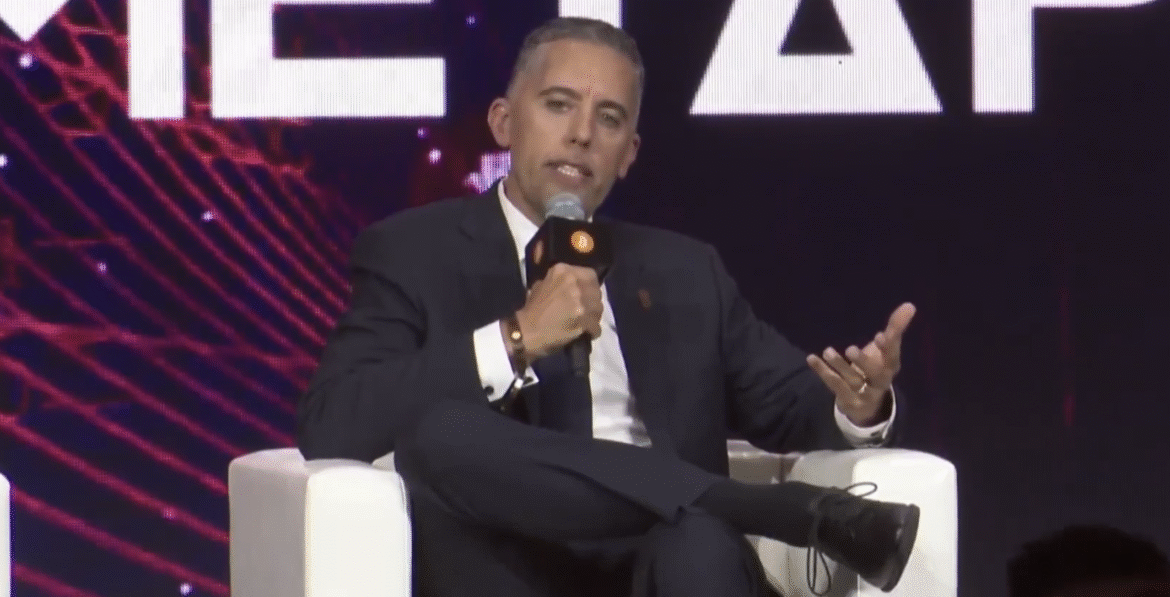From Ethiopia’s education system to a Wyoming health clinic, Hoskinson projects grand visions, but Cardano’s progress remains limited, uneven, and increasingly overshadowed by rivals.
Summary
- Charles Hoskinson promotes bold ventures in healthcare and de-extinction while Cardano, his blockchain, struggles to match rivals in adoption, liquidity, and developer engagement.
- Cardano’s smart contract rollout in 2021 proved rigid and discouraging for developers, pushing growth toward Ethereum and Solana, which now dominate in transactions, DeFi, and developer activity.
- Governance reforms have introduced budgeting and on-chain voting, yet disputes, abstentions, and concentration of power continue to raise doubts about Cardano’s independence and long-term direction.
- Hoskinson critiques Ethereum’s governance and design while pursuing side projects, but Cardano’s stalled adoption and weaker fundamentals suggest a widening gap between his rhetoric and delivery.
The Hoskinson pitch
In September 2025, Cardano (ADA) founder Charles Hoskinson returned to the spotlight at the Rare Evo conference in Las Vegas. Speaking to CoinDesk’s cameras, he declared that “health care is just f***ed in America” while unveiling a $200 million clinic project in Gillette, Wyoming.
He described the clinic as open-sourced and patient-first, saying it already serves about one-third of the town’s population. He added that patients unable to pay are not charged, and claimed the existing hospital was resisting the initiative by obstructing the credentialing of his doctors.
Hoskinson also promised that artificial intelligence agents and selective disclosure cryptography would eventually be built into the system.
Almost at the same time, Hoskinson returned to one of his long-running critiques of Ethereum (ETH). He argued that the “Magnificent Seven” technology firms could become the next gatekeepers of liquidity in crypto and may choose to bypass Ethereum altogether.
He repeated his prediction that Ethereum might not survive beyond the next 10 to 15 years, pointing to its reliance on external scaling solutions and what he considers weak architectural design.
That skepticism toward rivals has often gone hand in hand with bold promises about Cardano’s own reach.
In 2021, Hoskinson announced a partnership with Ethiopia’s Ministry of Education that was presented as a national breakthrough, with blockchain IDs promised for 5 million students and 750,000 teachers and academic records verified directly on Cardano.
The project was held up as proof of real-world adoption at scale. In 2024, Input Output Global described the effort instead as a set of lessons and reflections and noted that Atala PRISM, once central to the deal, had been folded into Hyperledger Identus.
That change reframed a flagship deployment into a learning exercise and placed the technology under a consortium standard rather than Cardano itself, undercutting the original narrative of transformative adoption.
With so much activity around Hoskinson and Cardano, it is worth looking more closely at where the project stands and how it compares with its competitors.
Solana and Ethereum run while Cardano crawls
In that same interview, Hoskinson made a rare admission. He conceded that Cardano “bet wrong” on its smart contract model in 2021.
He described it as too rigid and unfriendly for developers, a choice that pushed many builders toward faster-growing ecosystems like Solana (SOL).
The timeline shows how this unfolded. Cardano launched in 2017 but did not release general-purpose smart contracts until the Alonzo hard fork on September 12, 2021.
Expectations had been building for years, yet within days, developers ran into concurrency issues on early decentralized exchange testnets such as Minswap.
These problems came from Cardano’s extended UTXO architecture, which processes transactions differently from Ethereum’s account-based model. The design was promoted as more secure and predictable, but in practice, it made complex applications harder to build.
Hoskinson tried to dismiss the concerns as misunderstandings, yet the reality was that a long-promised feature arrived with friction that immediately discouraged developers.
Subsequent upgrades were introduced to close the gap. The Vasil hard fork, aimed at scaling and improving Plutus, was planned for June 2022 but slipped to late September. Each delay added to the impression that Cardano could not deliver at the pace of the broader industry.
While competitors were attracting projects across decentralized finance, NFTs, and tokenization, Cardano was still working to stabilize the basics of its smart contract environment.
Adoption numbers show the effect. As of Sep. 10, Cardano’s total value locked in DeFi stood near $390 million. Solana held about $12.5 billion. Ethereum remained far ahead at $93 billion.
The gap is not only about size but also about lost momentum. When liquidity and developers move elsewhere, the network effect builds against the slower chain.
Ethereum processed about 1.4 million smart contract executions per day in mid-2025. Cardano processed around 52,000. Developer activity reflected the same divide, with Ethereum supporting about 3,200 active monthly developers compared with Cardano’s 720.
The contrast with Solana makes the divergence sharper. Cardano entered the first quarter of 2025 with weaker fundamentals, averaging about 71.5k daily transactions, a 28% drop from the previous quarter.
Solana, in the same period, processed millions of daily transactions supported by a large wallet base. Average fees were about $0.00025, and throughput ranged between 40,000 and 65,000 transactions per second, with more efficiency promised through the Firedancer client.
A pattern becomes clear when all the data is combined. Cardano often arrives late, delivers less than expected, and then tries to present the outcome as part of a longer journey.
Governance or gatekeeping?
Cardano’s governance was designed as a three-part system. Input Output took responsibility for protocol development, the Cardano Foundation handled ecosystem promotion and standardization, and Emurgo focused on commercial applications.
The layered setup created complexity from the start and led to perceptions of centralization, rather than the decentralization Hoskinson often highlights as Cardano’s defining principle. The history of the project shows why.
In 2018, Hoskinson and Emurgo chief executive Ken Kodama publicly called for the resignation of the Cardano Foundation’s chairman. They accused the Foundation of weak community engagement and poor transparency.
That early clash set the tone for recurring disputes over how the project is governed. In early 2025, the Cardano Foundation, acting within Intersect’s governance framework, proposed a 30% reduction in the ecosystem’s draft budget.
The largest cut was directed at Input Output, whose allocation was set to fall by about 44%, from roughly 69.8 million ADA to 38.8 million ADA.
Hoskinson objected, warning that such reductions risked slowing core technical development. The dispute revived questions about how much independence these entities truly held and whether governance choices were aligned with Cardano’s long-term technical needs.
Meanwhile, in 2025, Cardano also introduced a structured annual budgeting process managed through elected delegates and Intersect committees.
For the first time, the community approved allocations via on-chain voting, covering both ecosystem funding and protocol governance. These governance steps were designed to improve accountability and transparency, but participation has remained limited.
As of May 2025, around 11.7 billion ADA have been delegated to governance representatives. Yet more than 6.2 billion ADA of that sits with the “Abstain” delegate and another 173 million ADA with “No Confidence.”
This means 68% of participants have opted out of active representation, leaving only about 48% of total voting power aligned with representatives able to cast votes.
The total ADA in circulation is 35.3 billion, but only about 33% has been delegated at all. Of that, just 14% of circulating ADA coins are actively delegated to autonomous representatives. A substantial share of potential voting influence, therefore, remains unused.
Since large portions of ADA on centralized exchanges are likely undelegated, these numbers reflect a relatively low level of engagement in governance.
Headline totals obscure how much of the system is effectively neutralized, leaving real decision-making power concentrated in a smaller portion of the network than the surface figures suggest.
Meanwhile, Cardano also became embroiled in a high-profile dispute over unclaimed ADA vouchers.
Allegations surfaced in May 2025 claiming that Hoskinson and IOG had manipulated the blockchain during the 2021 Allegra hard fork to seize about $600 million in ADA.
Hoskinson denied the accusations, and an independent 128-page audit carried out by law firm McDermott, Will & Schulte, together with accounting firm BDO, later cleared him of wrongdoing.
The report, released on Sep. 3, confirmed that nearly all vouchers issued through Cardano’s pre-launch sales were successfully redeemed and that unclaimed ADA had been properly moved into reserves.
Even so, the lack of clarity damaged confidence as investors questioned the project’s governance and transparency.
That backdrop makes Hoskinson’s criticism of Ethereum more pointed and more paradoxical. He has often described Ethereum as a dictatorship around Vitalik Buterin.
Ethereum’s governance is based on open proposals and informal consensus through processes such as Ethereum Improvement Proposals. Decisions evolve from broad community debate rather than from a central authority.
Cardano’s model, in contrast, continues to revolve around three main entities that hold considerable influence despite the introduction of on-chain mechanisms.
Cardano drifts as its founder chases side quests
Hoskinson has promoted the Hoskinson Health and Wellness Clinic as a $200 million investment in Gillette, Wyoming. Local reporting in 2022, however, estimated the combined renovation and land development costs at closer to $18 million.
Promises of artificial intelligence integration and cryptocurrency payment systems remain future projections rather than active features. His claims that patients who cannot pay are not charged come without transparent data on how many individuals have actually received such care.
There are no publicly available metrics on patient outcomes, service volume, or adoption of the blockchain features he now associates with the clinic’s mission.
At the same time Hoskinson remains invested in one of the more unusual ventures connected to the crypto world, the de-extinction movement.
He is a backer of Colossal Biosciences, a company that has raised more than $200 million with promises to bring back woolly mammoths, dodos, and Tasmanian tigers. The investor list includes names as varied as Paris Hilton.
Conservationists and geneticists argue that such projects resemble spectacle more than science and that the money could be better directed toward protecting endangered species that still exist.
Even insiders at Colossal have criticized the company’s narrative and said they faced smear campaigns when they questioned the approach.
The effect of these side ventures is puzzling. While Cardano continues to struggle with low decentralized finance traction, limited developer momentum, and a lackluster record of adoption, its founder is speaking more about curing healthcare or reviving long extinct animals than about strengthening Cardano’s ecosystem.
The contrast between rhetoric and delivery grows sharper with each new announcement. The question is whether these ventures represent bold experimentation or distractions that take attention away from building a blockchain able to compete with its peers.



